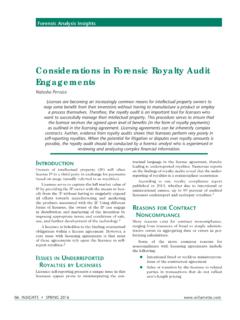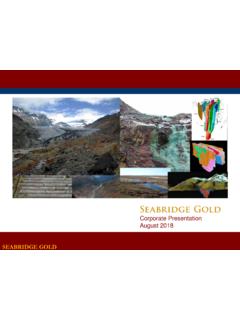Transcription of Mineral royalties and other mining- specific taxes - IM4DC
1 Mineral royalties and other mining - specific taxes Pietro GujInternational mining for Development Centre mining for Development: Guide to Australian Practice 2012. This work is copyright to the International mining for Development Centre ( IM4DC ), a joint venture between The University of Western Australia and the University of Queensland in partnership with the Australian Government through AusAID. It may be reproduced in whole or in part subject to the inclusion of an acknowledgment of the source and no commercial usage or sale.
2 Reproduction for purposes other than those indicated above require written permission from the IM4DC Director, 35 Stirling Highway, Crawley, WA 6009, International mining for Development Centre has been established to promote more sustainable use of minerals and energy resources in developing nations by assisting governments and civil society organisations though delivery of education and training, fellowships, research and advice. Our focus is on three core themes of Governance and Regulation, Community and Environmental Sustainability, and Operational by Pietro Guj Research Professor Centre for Exploration Targeting, The University of Western AustraliaCentre for Exploration Targeting (CET) was established in 2005 as an unincorporated joint venture between the Mineral exploration industry, the University of Western Australia, Curtin University and the Government of Western Australia.
3 Report does not necessarily represent the views or the policy of AusAID or the Commonwealth of for and the extraction and processing of minerals are generally (but not exclusively) carried out by private sector companies, despite the public ownership of Mineral resources. Companies are often exposed to significant risks that flow from the substantial capital investments required, the long exploration and pre-production periods during which no revenue is generated, and the generally long life of mining projects, paired to the volatility of commodity markets as well as other technical and environmental uncertainties inherent in individual mining the other hand, given the volatility in the price of Mineral commodities.
4 mining operations have the capacity to generate surplus revenues in excess of all costs of production. This surplus is known as economic rent1, and it is calculated as the margin realised after netting off from the gross Mineral revenue all the costs of production (recurrent and capital recovery costs) as well as a minimum return on capital high enough to attract capital and retain it in the project. This minimum required return on capital, termed normal profit , compensates investors for foregoing the next best alternative investment opportunities, as well as for the timing and risk of the uncertain cash flows expected from the in excess of costs of production (economic rent), where costs of production include normal profit, is the target of special taxation regimes in the mining sector.
5 The practical issue for governments, however, is how to design tax regimes that best meet their objectives. This paper provides a review of Mineral royalties and other special taxes which apply specifically to the mining sector in Mineral -rich countries, with emphasis on current arrangements in Australia. Mineral royalties have traditionally been considered a form of compensation to the community for the depletion of non-renewable resources. Special mining taxes including royalties are additional to the general income taxes and other forms of taxation levied on all sectors of an economy.
6 They represent, therefore, different ways for governments to levy an additional share of the revenue flowing from mining operations relative to other non- mining paper sets out the objectives sought by governments in imposing these special taxes and then provides an analysis of the different forms in which these special taxes may be imposed. The importance of the mining sector in the Australian economy and the special taxation regimes imposed by some of the Australian States and the Commonwealth (federal) Government are also discussed as examples of the application of different fiscal paper concludes with consideration of some pertinent enforcement and administrative issues that need serious consideration in designing a best practice mining sector taxation most jurisdictions throughout the world Mineral resources are, with some rare exceptions, in public rather than private ownership.
7 Mineral resources are finite and non-renewable in the sense that their extraction permanently depletes a country s resource inventory. The role of governments should be to manage the exploitation of these resources to maximise the economic benefits to their community, consistent with the need to attract and retain the exploration and development capital necessary to continue to realise these benefits for as long as For a more in depth discussion about the nature of economic rents in mining the reader can refer to Harman and Guj, 2006 and Otto et al.
8 , paper provides a review of Mineral royalties and other special taxes which apply specifically to the mining sector in Mineral -rich countries, with emphasis on current arrangements in Australia. 4 Mineral royalties anD other mining - specific taxes Mineral taxesMineral royalty and tax types and their characteristicsAs special taxes for the mining sector are, in principle, directed at the net value of the Mineral resource after the deduction of costs of production including normal profits, they should be levied as close as possible to the point of extraction.
9 That is to say at the run of mine (ROM) ore pad and not on any value added by further processing or transport to markets. In practice very few, if any, Mineral commodities are sold at-arm s-length at this taxing point, which generates problems with establishing the value of the resource on which a special tax should be must also be noted that special taxes for the mining sector are levied at the project level, rather than, as is commonly the case for corporate income tax, at the consolidated entity level. In most jurisdictions, these special taxes are a legitimate deduction in assessing corporate income taxes for the mining sector generally take the following forms: Unit based ( specific ) royalties when the tax base is a physical unit (volume or weight); Ad valorem royalties based on the value of production; Profit based royalty or tax when the tax base is an accounting concept of profit; Economic rent based when the tax base is a direct measure of economic rent.
10 Hybrid systems combining a profit or rent based system with an ad valorem system; and other methods when a variety of tax bases are used, including production sharing. The term Mineral royalty has traditionally been applied in mining legislation when referring to specific , ad valorem and, in some cases, mining taxes based on an accounting profit effect, all of the forms set out above are alternative ways for governments to appropriate economic rents unique to mining and are applied in addition to the general corporate income tax and other forms of taxation that cover all sectors of an economy.











